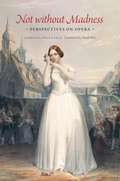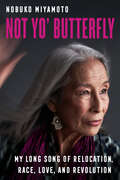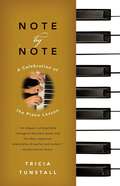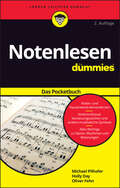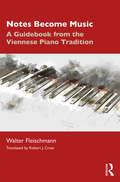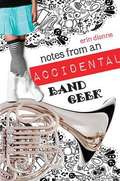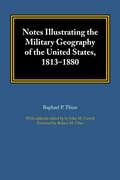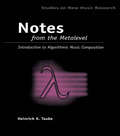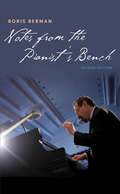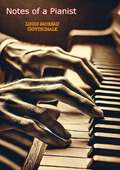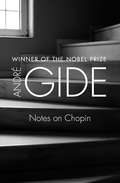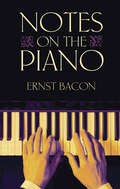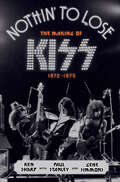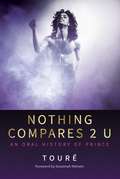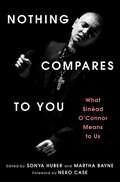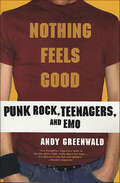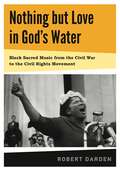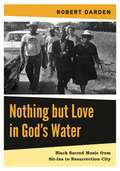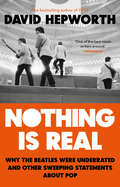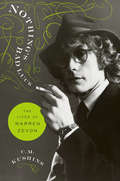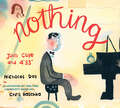- Table View
- List View
Not Without Madness: Perspectives on Opera
by Fabrizio Della SetaOpera often seems to arouse either irrational enthusiasm or visceral dislike. Such madness, as Goethe wrote, is indispensable in all theater, and yet in practice, sentiment and passion must be balanced by sense and reason. Exploring this tension between madness and reason, Not without Madness presents new analytical approaches to thinking about eighteenth- and nineteenth-century opera through the lenses of its historical and cultural contexts. In these twelve essays, Fabrizio Della Seta explores the concept of opera as a dramatic event and an essential moment in the history of theater. Examining the meaning of opera and the devices that produce and transmit this meaning, he looks at the complex verbal, musical, and scenic mechanisms in parts of La sonnambula, Ernani, Aida, Le nozze di Figaro, Macbeth, and Il trovatore. He argues that approaches to the study of opera must address performance, interpretation, composition, reception, and cultural ramifications. Purely musical analysis does not make sense unless we take into account music's dramatic function. Containing many essays available for the first time in English, Not without Madness bridges recent divisions in opera studies and will attract musicologists, musicians, and opera lovers alike.
Not Yo' Butterfly: My Long Song of Relocation, Race, Love, and Revolution (American Crossroads #60)
by Nobuko MiyamotoA mold-breaking memoir of Asian American identity, political activism, community, and purpose.Not Yo’ Butterfly is the intimate and unflinching life story of Nobuko Miyamoto—artist, activist, and mother. Beginning with the harrowing early years of her life as a Japanese American child navigating a fearful west coast during World War II, Miyamoto leads readers into the landscapes that defined the experiences of twentieth-century America and also foregrounds the struggles of people of color who reclaimed their histories, identities, and power through activism and art. Miyamoto vividly describes her early life in the racialized atmosphere of Hollywood musicals and then her turn toward activism as an Asian American troubadour with the release of A Grain of Sand—considered to be the first Asian American folk album. Her narrative intersects with the stories of Yuri Kochiyama and Grace Lee Boggs, influential in both Asian and Black liberation movements. She tells how her experience of motherhood with an Afro-Asian son, as well as a marriage that intertwined Black and Japanese families and communities, placed her at the nexus of the 1992 Rodney King riots—and how she used art to create interracial solidarity and conciliation. Through it all, Miyamoto has embraced her identity as an Asian American woman to create an antiracist body of work and a blueprint for empathy and praxis through community art. Her sometimes barbed, often provocative, and always steadfast story is now told.
Not without Madness: Perspectives on Opera
by Fabrizio Della SetaOpera often seems to arouse either irrational enthusiasm or visceral dislike. Such madness, as Goethe wrote, is indispensable in all theater, and yet in practice, sentiment and passion must be balanced by sense and reason. Exploring this tension between madness and reason, Not without Madness presents new analytical approaches to thinking about eighteenth- and nineteenth-century opera through the lenses of its historical and cultural contexts. In these twelve essays, Fabrizio Della Seta explores the concept of opera as a dramatic event and an essential moment in the history of theater. Examining the meaning of opera and the devices that produce and transmit this meaning, he looks at the complex verbal, musical, and scenic mechanisms in parts of La sonnambula, Ernani, Aida, Le nozze di Figaro, Macbeth, and Il trovatore. He argues that approaches to the study of opera must address performance, interpretation, composition, reception, and cultural ramifications. Purely musical analysis does not make sense unless we take into account music’s dramatic function. Containing many essays available for the first time in English, Not without Madness bridges recent divisions in opera studies and will attract musicologists, musicians, and opera lovers alike.
Note by Note: A Celebration of the Piano Lesson
by Tricia TunstallIn this luminous book, Tricia Tunstall explores the enduring fascination of the piano lesson. Even as everything else about the world of music changes, the piano lesson retains its appeal. Drawing on her own lifelong experience as a student and teacher, Tunstall writes about the mysteries and delights of piano teaching and learning. What is it that happens in a piano lesson to make it such a durable ritual? In a world where music is heard more often on the telephone and in the elevator than in the concert hall, why does the piano lesson still have meaning in the lives of children? What does it matter whether one more child learns to play Bach's Minuet in G? Note by Note is in part a memoir in which Tunstall recalls her own childhood piano teachers and their influence. As she observes, the piano lesson is unlike the experience of being coached on an athletic team or taught in a classroom, in that it is a one-on-one, personal communication. Physically proximate, mutually concentrating on the transfer of a skill that is often arduous, complicated and frustrating, teacher and student occasionally experience breakthroughs-moments of joy when the student has learned something, mastered a musical passage or expressed a feeling through music. The relationship is not only one-way: teaching the piano is a lifelong endeavor of particular intensity and power. Anyone who has ever studied the piano-or wanted to-will cherish this gem of a book.
Notenlesen für Dummies Das Pocketbuch (Für Dummies)
by Michael Pilhofer Holly Day Oliver FehnSpielen Sie mit dem Gedanken, ein Instrument zu erlernen? Oder sind Sie schon seit Jahren passionierter Gitarrist, der wunderbar nach Tabulaturen spielt, bei Notenblättern jedoch kapituliert? In jedem Fall werden Sie Ihr musikalisches Potenzial enorm erhöhen, wenn Sie die Sprache der Musik beherrschen. Dieses Buch erklärt Ihnen leicht verständlich, was es mit Noten- und Pausenwerten auf sich hat, welche anderen Symbole wichtig sind und was Sie über Rhythmus und Co. wissen müssen. Die neue Auflage wurde um praktische Übungen erweitert.
Notes Become Music: A Guidebook from the Viennese Piano Tradition
by Walter FleischmannNotes Become Music: A Guidebook from the Viennese Piano Tradition addresses the many unwritten nuances of dynamics, articulation and agogics as an expression of fundamental principles of a common European musical language. It treats the score as an incomplete musical shorthand that outlines the compositional and interpretive imperatives implicit within it, drawing on historical records from the eighteenth and nineteenth centuries and detailed comparisons of works to underline the author’s presentation of Viennese tradition. This book is not primarily concerned with questions of style or interpretation. Rather, it explains the many facets of musical notation that were taken for granted by composers who assumed a knowledge of the piano tradition of their day. Notes Become Music informs not only those students in countries where the central European music tradition is still unfamiliar, but also a younger generation of Europeans who have grown up without a living connection to their musical past.
Notes From An Accidental Band Geek
by Erin DionneFrom the author of Models Don’t Eat Chocolate Cookies comes a middle grade novel hailed by Linda Urban as "A perfect blend of laugh out loud funny and real-world heart. ” Elsie Wyatt wants to be an orchestra superstar, like her dad and grandfather. The first step? Get into a super-selective summer music camp. In order to qualify, Elsie must "expand her musical horizons” by joining her high school’s marching band. Not only does this mean wearing a plumed hat and polyester pants, but it also means she can’t play her own instrument, can’t sit down, and can’t seem to say the right thing to anyone...let alone Jake, the cute trumpet player she meets on the first day. Plus, everything she does seems to cause a disaster. Surviving marching band is going to be way harder than Elsie thought. For fans of funny, realistic, every-girl novels like Wendy Mass’s 13 Gifts and Lisa Greenwald’s My Life in Pink & Green. "It has humor, heart, and a touch of romance that will provide ample fodder for booktalks. ”-School Library Journal "Marching-band kids everywhere will enjoy this believable celebration of a life-changing, musical rite of passage. ”-Kirkus .
Notes Illustrating the Military Geography of the United States, 1813–1880
by Raphael P. ThianWhen the Adjutant General's Office published Raphael Thian's "notes" on U.S. military geography in 1880, it produced an invaluable research tool for generations of military historians to come. In this single documented reference volume, Chief Clerk Thian traced the confusing mutations through which the divisions, departments, and districts of the Army's command had evolved since 1813. The volume is divided into three parts, beginning with the names of the United States Army Continental Commands, the date and authority for their creation, location of the headquarters, geographical changes and discontinuances, and other details including the geographical boundaries embracing each division, department, and district. Part II is filled with background information on states and territories, and Part III lists the maps contained in The Military Atlas of the United States. The Addenda to this edition expand and update Thian's work. Notes made by Francis B. Heitman to keep his personal copy current are included, as is the Memorandum published by the government in 1906. This addition lists all changes from 1898 through 1905.
Notes from the Metalevel: An Introduction to Computer Composition
by Heinrich TaubeFirst Published in 2005. Routledge is an imprint of Taylor & Francis, an informa company.
Notes from the Pianist's Bench: Second Edition, Multimedia Edition
by Boris BermanA master class on piano performance and pedagogy from the world-renowned concert pianist In this newly revised edition of a comprehensive guide to piano technique, performance, and music interpretation, renowned performing musician, recording artist, and teacher Boris Berman addresses virtually every aspect of musical artistry and pedagogy. Ranging from such practical matters as sound, touch, and pedaling to the psychology of performing and teaching, this essential volume provides a master class for the performer, instructor, and student alike. It is also available as a multimedia e-Book.
Notes of a Pianist: During His Professional Tours In The United States, Canada, The Antilles, And South America: Preceded By A Short Biographical Sketch With Contemporaneous Criticisms
by Louis Moreau GottschalkExperience the life and thoughts of a musical prodigy through the captivating memoir, "Notes of a Pianist," by Louis Moreau Gottschalk. This extraordinary book offers a rare glimpse into the mind of one of the 19th century's most celebrated pianists and composers, providing readers with an intimate portrait of his artistic journey and the vibrant world of classical music.Louis Moreau Gottschalk, a virtuoso pianist renowned for his exceptional talent and innovative compositions, takes readers on a fascinating journey through his life, from his early years in New Orleans to his international tours and triumphs. "Notes of a Pianist" is a collection of diary entries, letters, and reflections that chronicle Gottschalk's experiences, thoughts, and observations as he navigates the highs and lows of a career in music.The book delves into Gottschalk's creative process, offering insights into his inspirations, influences, and the challenges he faced as a pioneering artist. He shares his encounters with other musical legends, the cultural and political landscapes of the places he visited, and the personal joys and sorrows that shaped his music.Gottschalk's writing is infused with wit, passion, and a keen sense of observation, making "Notes of a Pianist" not only a valuable historical document but also a compelling and entertaining read. His vivid descriptions of performances, audiences, and the artistic milieu of the 19th century bring to life the world of classical music in a way that is both informative and engaging.This memoir is an essential read for music lovers, historians, and anyone interested in the life of a remarkable artist. Gottschalk's reflections provide a unique perspective on the development of American classical music and the global influence of his work.
Notes on Chopin
by André GideAn inspiring discourse on the power of music from one of the twentieth century&’s most important figures, André Gide André Gide, one of the great intellectuals of the twentieth century and a devoted pianist, invites readers to reevaluate Frédéric Chopin as a composer &“betrayed . . . deeply, intimately, totally violated&” by a music community that had fundamentally misinterpreted his work. As a profound admirer of Chopin&’s &“promenade of discoveries,&” Gide intersperses musical notation throughout the text to illuminate his arguments, but most moving is Gide&’s own poetic expression for the music he so loved. This edition includes rare pages and fragments from Gide&’s journals, which relate to Chopin and music.
Notes on Chopin
by André GideAn inspiring discourse on the power of music from one of the twentieth century&’s most important figures, André Gide André Gide, one of the great intellectuals of the twentieth century and a devoted pianist, invites readers to reevaluate Frédéric Chopin as a composer &“betrayed . . . deeply, intimately, totally violated&” by a music community that had fundamentally misinterpreted his work. As a profound admirer of Chopin&’s &“promenade of discoveries,&” Gide intersperses musical notation throughout the text to illuminate his arguments, but most moving is Gide&’s own poetic expression for the music he so loved. This edition includes rare pages and fragments from Gide&’s journals, which relate to Chopin and music.
Notes on the Piano (Dover Books on Music)
by Sara Davis Buechner Ernst Bacon"Should be a bedside reader for every author, composer, singer, critic, or layman interested in music." -- Critic's ChoiceAn accomplished composer, pianist, writer, and teacher presents an easy and entertaining guide for players at all levels of expertise. Ernst Bacon offers valuable tips on working, listening, and playing habits in five sections that cover "The Performer," "The Learner," "The Player and Writer," "The Observer," and "Technically Speaking." This edition features an informative Introduction by virtuoso pianist and professor Sara Davis Buechner.
Nothin' to Lose: The Making of KISS 1972–1975
by Ken Sharp Paul Stanley Gene SimmonsNothin' to Lose: The Making of KISS (1972-1975) chronicles, for the first time, the crucial formative years of the legendary rock band KISS, culminating with the groundbreaking success of their classic 1975 album Alive! and the smash single "Rock and Roll All Nite," a song that nearly four decades later remains one of rock's most enduring anthems. Drawing on more than two hundred interviews, the book offers a captivating and intimate fly-on-the-wall account of their launch, charting the struggles and ultimate victories that led them to the threshold of superstardom.Constructed as an oral history, the book includes original interviews with Paul Stanley, Gene Simmons, Ace Frehley, and Peter Criss, as well as with producers; engineers; management; record company personnel; roadies; club owners; booking agents; concert promoters; costume, stage, and art designers; rock photographers; publicists; and key music journalists.Many of KISS's musical contemporaries from the time, most of whom shared concert bills with the band on their early tours, also lend their perspective via new interviews; these include Bob Seger, Alice Cooper, and Ted Nugent, as well as members of Aerosmith, Black Sabbath, Rush, Slade, Blue Öyster Cult, Mott the Hoople, Journey, REO Speedwagon, Styx, Raspberries, The James Gang, The New York Dolls, Iggy & the Stooges, The Ramones, Suzi Quatro, Argent, and Uriah Heep, among others.The result is an indelible and irresistible portrait of a band on the rise and of the music scene they changed forever.
Nothing Compares 2 U: An Oral History of Prince
by TouréThe real Prince in the words of those who knew him best—from award-winning author Touré.Nothing Compares 2 U is an oral history built from years of interviews with dozens of people who were in Prince&’s inner circle—from childhood friends to band members to girlfriends to managers to engineers to photographers, and more—all providing unique insights into the man and the musician. This revelatory book is a deeply personal and candid discussion of who Prince really was emotionally, professionally, and romantically. It tackles subjects never-before-discussed, including Prince&’s multiple personalities, his romantic relationships, his traumatic childhood and how it propelled him into his music career, and how he found the inspiration for some of his most important songs, including &“Purple Rain,&” &“Starfish and Coffee,&” and the unheard &“Wally.&” Nothing Compares 2 U paints the most complete picture yet written of the most important and most mysterious artist of his time.
Nothing Compares to You: What Sinead O'Connor Means to Us
by Martha Bayne Sonya HuberAn intimate and evocative celebration of the life and legacy of music and political icon Sinéad O&’Connor, featuring writers including Neko Case, Sinéad Gleeson, Rayne Fisher-Quann, Porochista Khakpour, and more.More than thirty years ago, Sinéad O&’Connor shocked the world by tearing up a photo of Pope John Paul II in an act of protest against the violence perpetrated by the Catholic Church. This single act cemented O&’Connor&’s place as a fearless voice and activist that would later push even further as Sinead became an advocate for HIV/AIDS awareness, the LGBTQ+ community, and abortion rights. Here in Nothing Compares to You, a renowned and multi-generational group of women and non-binary authors come together to pay tribute to O&’Connor&’s impact on our world and in their own lives and development as humans and artists. Nothing Compares to You is a loving and accessible reconsideration and entry point for understanding the Irish icon. Exploring themes such as gender identity, spirituality, artistic expression, and personal transformation, this collection shows that Sinead&’s voice continues to ring on even after her death and brilliantly illustrates the power of creative expression to inspire far beyond any presumed lines of age, culture, or class.
Nothing Feels Good: Punk Rock, Teenagers, and Emo
by Andy GreenwaldNothing Feels Good: Punk Rock, Teenagers, and Emo tells the story of a cultural moment that's happening right now-the nexus point where teen culture, music, and the web converge to create something new.While shallow celebrities dominate the headlines, pundits bemoan the death of the music industry, and the government decries teenagers for their morals (or lack thereof) earnest, heartfelt bands like Dashboard Confessional, Jimmy Eat World, and Thursday are quietly selling hundreds of thousands of albums through dedication, relentless touring and respect for their fans. This relationship - between young people and the empathetic music that sets them off down a road of self-discovery and self-definition - is emo, a much-maligned, mocked, and misunderstood term that has existed for nearly two decades, but has flourished only recently. In Nothing Feels Good, Andy Greenwald makes the case for emo as more than a genre - it's an essential rite of teenagehood. From the '80s to the '00s, from the basement to the stadium, from tour buses to chat rooms, and from the diary to the computer screen, Nothing Feels Good narrates the story of emo from the inside out and explores the way this movement is taking shape in real time and with real hearts on the line. Nothing Feels Good is the first book to explore this exciting moment in music history and Greenwald has been given unprecedented access to the bands and to their fans. He captures a place in time and a moment on the stage in a way only a true music fan can.
Nothing but Love in God's Water: Volume 1: Black Sacred Music from the Civil War to the Civil Rights Movement
by Robert DardenThe first of two volumes chronicling the history and role of music in the African American experience, Nothing but Love in God’s Water explores how songs and singers helped African Americans challenge and overcome slavery, subjugation, and suppression. From the spirituals of southern fields and the ringing chords of black gospel to the protest songs that changed the landscape of labor and the cadences sung before dogs and water cannons in Birmingham, sacred song has stood center stage in the African American drama. Myriad interviews, one-of-a-kind sources, and rare or lost recordings are used to examine this enormously persuasive facet of the movement. Nothing but Love in God’s Water explains the historical significance of song and helps us understand how music enabled the civil rights movement to challenge the most powerful nation on the planet.
Nothing but Love in God's Water: Volume 1: Black Sacred Music from the Civil War to the Civil Rights Movement
by Robert DardenThe first of two volumes chronicling the history and role of music in the African American experience, Nothing but Love in God’s Water explores how songs and singers helped African Americans challenge and overcome slavery, subjugation, and suppression. From the spirituals of southern fields and the ringing chords of black gospel to the protest songs that changed the landscape of labor and the cadences sung before dogs and water cannons in Birmingham, sacred song has stood center stage in the African American drama. Myriad interviews, one-of-a-kind sources, and rare or lost recordings are used to examine this enormously persuasive facet of the movement. Nothing but Love in God’s Water explains the historical significance of song and helps us understand how music enabled the civil rights movement to challenge the most powerful nation on the planet.
Nothing but Love in God’s Water: Volume 2: Black Sacred Music from Sit-Ins to Resurrection City
by Robert DardenVolume 1 of Nothing but Love in God’s Water traced the music of protest spirituals from the Civil War to the American labor movement of the 1930s and 1940s, and on through the Montgomery bus boycott. This second volume continues the journey, chronicling the role this music played in energizing and sustaining those most heavily involved in the civil rights movement.Robert Darden, former gospel music editor for Billboard magazine and the founder of the Black Gospel Music Restoration Project at Baylor University, brings this vivid, vital story to life. He explains why black sacred music helped foster community within the civil rights movement and attract new adherents; shows how Martin Luther King Jr. and other leaders used music to underscore and support their message; and reveals how the songs themselves traveled and changed as the fight for freedom for African Americans continued. Darden makes an unassailable case for the importance of black sacred music not only to the civil rights era but also to present-day struggles in and beyond the United States.Taking us from the Deep South to Chicago and on to the nation’s capital, Darden’s grittily detailed, lively telling is peppered throughout with the words of those who were there, famous and forgotten alike: activists such as Rep. John Lewis, the Reverend Ralph Abernathy, and Willie Bolden, as well as musical virtuosos such as Harry Belafonte, Duke Ellington, and The Mighty Wonders. Expertly assembled from published and unpublished writing, oral histories, and rare recordings, this is the history of the soundtrack that fueled the long march toward freedom and equality for the black community in the United States and that continues to inspire and uplift people all over the world.
Nothing is Real: The Beatles Were Underrated And Other Sweeping Statements About Pop
by David HepworthPop music’s a simple pleasure. Is it catchy? Can you dance to it? Do you fancy the singer?But what’s fascinating about pop is our relationship with it. David Hepworth is interested in the human side of pop. He’s interested in how people make the stuff and, more importantly, what it means to us. In this collection of essays written throughout his career, Hepworth shows how it is possible to take music seriously and, at the same time, not drain the life out of it. From the legacy of the Beatles to the dramatic decline of the record shop via the bewildering nomenclature of musical genres; with characteristic insight and humour Hepworth asks some essential questions about music and, indeed, life: is it all about the drummer; are band managers misunderstood; and is it appropriate to play ‘Angels’ at funerals?As Pope John Paul II said ‘of all the unimportant things, football is the most important’. David Hepworth believes the same to be true of music and this selection of his best writing, covering the music of last fifty years, shows you precisely why.‘This collection offers counterintuitive takes on everything from Sixties B-sides to wedding music’ - GQ
Nothing's Bad Luck: The Lives of Warren Zevon
by C. M. KushinsBiography of legendary singer-songwriter Warren Zevon, spanning his nomadic youth and early recording career to his substance abuse, final album, and posthumous Grammy AwardsAs is the case with so many musicians, the life of Warren Zevon was blessed with talent and opportunity yet also beset by tragedy and setbacks. Raised mostly by his mother with an occasional cameo from his gangster father, Warren had an affinity and talent for music at an early age. Taking to the piano and guitar almost instantly, he began imitating and soon creating songs at every opportunity. After an impromptu performance in the right place at the right time, a record deal landed on the lap of a teenager who was eager to set out on his own and make a name for himself. But of course, where fame is concerned, things are never quite so simple.Drawing on original interviews with those closest to Zevon, including Crystal Zevon, Jackson Browne, Mitch Albom, Danny Goldberg, Barney Hoskyns, and Merle Ginsberg, Nothing's Bad Luck tells the story of one of rock's greatest talents. Journalist C.M. Kushins not only examines Zevon's troubled personal life and sophisticated, ever-changing musical style, but emphasizes the moments in which the two are inseparable, and ultimately paints Zevon as a hot-headed, literary, compelling, musical genius worthy of the same tier as that of Bob Dylan and Neil Young.In Nothing's Bad Luck, Kushins at last gives Warren Zevon the serious, in-depth biographical treatment he deserves, making the life of this complex subject accessible to fans old and new for the very first time.
Nothing: John Cage and 4'33"
by Nicholas DayWhat does nothing sound like? An offbeat history of John Cage&’s 4&’33&”, a musical composition of blank bars, illustrated by Caldecott Medalist Chris Raschka.One night in 1952, master pianist David Tudor took the stage in a barnlike concert hall called the Maverick. A packed audience waited with bated breath for him to start playing. Little did they know that the performance had already begun. A rain patters.A tree rustles.An audience stirs. David was performing John Cage&’s 4&’33&”, whose purpose is to amplify the ambient sounds of whatever venue it inhabits. That shocking first performance earned 4&’33&” plenty of haters; and yet the piece endures, &“performed&” by the smallest garage bands and the grandest symphonies alike, year after year. Its fans hear what John Cage hoped we would hear: &“Nothing&” is never silent, and you don&’t need a creative genius, a concert hall, or even a piano to hear something worthwhile. All you have to do is stop and listen.Nicholas Day&’s text is reverent with a healthy drop of humor, warm and refined; two-time Caldecott Medalist Chris Raschka&’s childlike pencil-on-watercolor artwork is uninhibited and electrifying, with all the visionary spirit of the work it chronicles. Guaranteed to spark generative thought and lively debate among readers of all ages, Nothing is not to be missed.A Junior Library Guild Gold Standard Selection
Notorious B.I.G. (Superstars of Hip-Hop)
by Z. B. HillYears after his death, Notorious B.I.G. is still thought of as one of the greatest rappers of all time. Fans haven't forgotten Biggie's impact on the hip-hop world. Big helped to make hip-hop what it is today. Without Notorious B.I.G., hip-hop would be very different today! Notorious B.I.G. tells the story of how Christopher Wallace used his gifts to become a megastar. Readers will also learn about how hip-hop became popular around the world thanks to help from Biggie.
